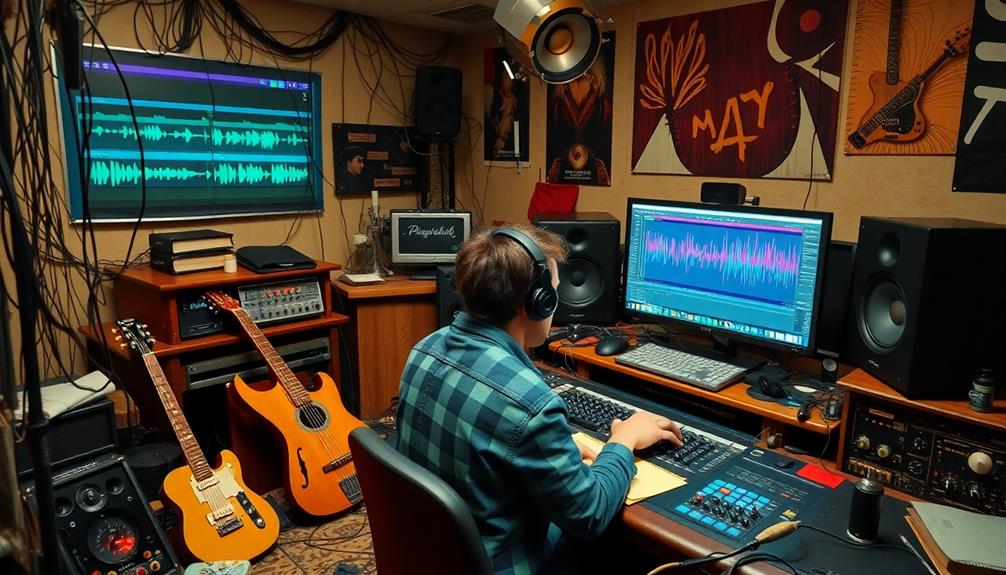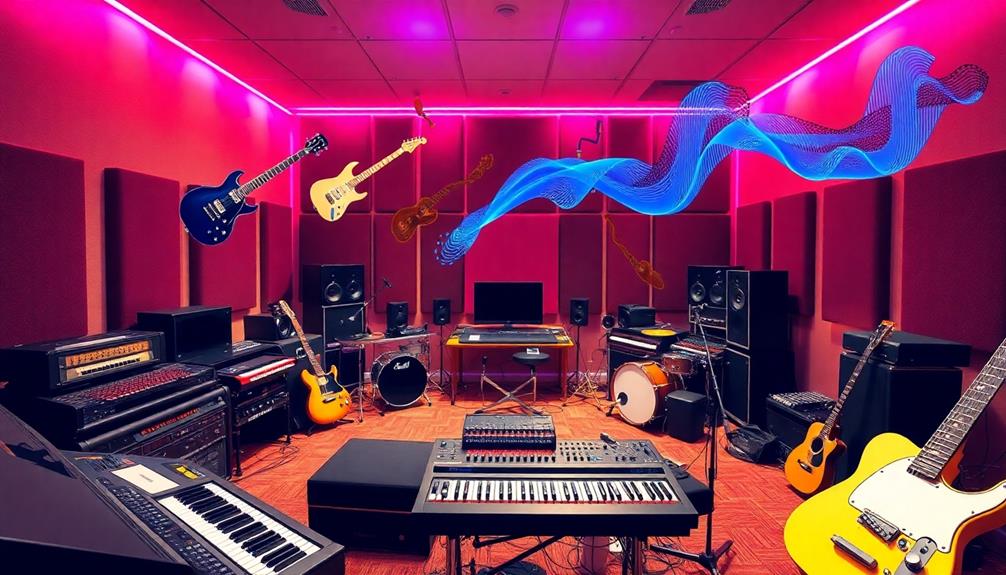To build complex, layered sounds that stand out, start by combining multiple audio tracks. Focus on frequency management to prevent muddiness and use EQ to carve out space for each layer. Panning techniques can enhance spatial separation, giving each element room to shine. Begin with two complementary sounds, gradually adding layers for richness. Don't forget modulation effects like reverb and chorus to elevate emotional impact. Regularly evaluate your mix to maintain balance and cohesion. Mastering these skills will set you on the path to professional-quality sound, and there's much more to explore about refining your craft.
Key Takeaways
- Start with complementary patches and gradually layer sounds to create clarity and richness in your mix.
- Use EQ to manage frequency overlap and prevent muddiness, ensuring each layer has its own space.
- Incorporate modulation effects like chorus and reverb to enhance emotional impact and add depth to your sounds.
- Regularly evaluate your mix in different environments to identify issues and maintain balance across layers.
- Experiment with octaves and intervals to add complexity and dynamic interest to your melodies.
Understanding Sound Layering

When you're delving into sound layering, it's vital to understand how combining multiple audio tracks can elevate your music. Sound layering lets you create a rich, textured sound that captivates listeners. To achieve this, you'll want to layer different sounds effectively, making sure they occupy distinct frequency ranges. This prevents muddiness and keeps your mix clear.
Using EQ is a powerful tool in this process. It allows you to carve out space for each layer, helping them sit well together in the mix. You might also experiment with panning sounds differently to create spatial separation, giving each layer its own sonic space.
Consider using multiple instances of the same patch with slight variations, like detuning, to add depth and richness to your audio. Regularly evaluating your mix is fundamental. This guarantees all layers work together cohesively, maintaining a balance that prevents any single layer from overpowering others.
Effective Layering Techniques

Building on your understanding of sound layering, effective layering techniques are essential to achieving a polished and professional sound in your music. Start with two complementary patches and gradually add more layers, making certain each layer has a distinct role in the mix. This approach maintains clarity and prevents muddiness, which is vital for complex audio.
Additionally, employing actionable tips and strategies can help you refine your layering process and enhance your overall sound design.
Use slight detuning on multiple instances of the same patch to enrich the texture without overcrowding the mix. Experiment with panning to create spatial separation between layers, enhancing the overall depth and texture of your sounds. Employ EQ to carve out specific frequency ranges for each audio track, preventing frequency masking and guaranteeing clarity.
Incorporate modulation effects such as chorus, reverb, and automation to add depth and movement to your layered sounds. These techniques enhance their emotional impact, making your mix more engaging.
Finally, regularly evaluate your mix by listening in different environments. Make adjustments as needed to maintain balance and confirm that all layers contribute positively to the overall sound.
Choosing the Right Sounds

Choosing the right sounds is essential for creating a compelling mix that resonates with listeners. When layering different sounds, prioritize complementary tones and textures to guarantee a harmonious blend. Experimenting with experimental octaves and intervals can add complexity and interest, enriching your melodic elements.
Here's a quick reference table to guide your sound selection:
| Sound Type | Characteristics | Emotional Impact |
|---|---|---|
| Percussive Sounds | Sharp, rhythmic | Energetic, uplifting |
| Ambient Pads | Soft, ethereal | Calm, introspective |
| Bass Elements | Deep, resonant | Powerful, grounding |
Utilizing high-quality sample libraries gives you access to well-crafted sounds, enhancing your mix. When you layer several sounds, think about how they interact; stacking sounds improperly can lead to a cluttered mix. Regularly reference professional tracks within your genre to inspire your choices and identify effective sound combinations. Understanding the emotional impact of each sound will help align your selections with the intended feel of your track, ultimately making your music more engaging.
Common Layering Challenges

Layering sounds can present a host of challenges that can trip up even seasoned producers. One of the most common layering challenges is finding sounds that complement each other without clashing. If you don't manage your mix properly, you risk creating a cluttered sound that lacks clarity and definition.
Over-relying on presets can also lead to uninspired layering; exploring custom sound design is essential to craft unique sound combinations. Additionally, understanding the differences between machine learning and AI can offer insights into how algorithm-driven tools can assist in sound selection and layering.
Striking the right balance between experimenting with sounds and maintaining your original vision is vital. You want to create a cohesive sound that resonates emotionally, but mismatched emotions can lead to disjointed tracks.
Keep the emotional impact of your chosen sounds in mind as you layer them, ensuring they align with your overall theme.
Be cautious of phase cancellation as well; layering identical sounds can cause significant issues in your mix, resulting in muddiness.
Advanced Layering Strategies

To create truly enchanting layered sounds, start by selecting complementary patches that enhance each other, much like how Blue Skies and Lemonade captures the essence of a perfect day.
Then, incorporate modulation and effects techniques to add movement and complexity, making your mix feel alive.
Complementary Sound Selection
A well-crafted sound selection can greatly enhance your music's overall impact. By focusing on complementary sounds, you can layer multiple elements that boost each other's qualities. For instance, pairing a bright synth with a warm pad creates a rich harmonic texture that enthralls listeners.
Don't shy away from using distinct sounds, like combining a punchy kick drum with a soft, ambient pad; this contrast adds dynamic interest and keeps your mix engaging.
To create new layers of complexity, experiment with different octaves and intervals for your melodic elements. Layer several melodies, each in a unique range, to produce a fuller sound that resonates on various levels. Incorporating sounds from different genres, such as blending acoustic instruments with electronic elements, can also lead to innovative soundscapes.
Regularly evaluate how each sound interacts within the frequency spectrum. Adjusting your EQ settings guarantees clarity and cohesion, preventing frequency masking that can lead to muddiness.
Modulation and Effects Techniques
When crafting complex, layered sounds, modulation and effects techniques play a pivotal role in enhancing your mix. Utilizing modulation effects like chorus, flanger, or phaser can add movement and richness to your layered sounds, creating a sense of depth and complexity that captivates listeners.
Here are three advanced techniques to reflect upon:
- Automation of Modulation: Dynamically adjust parameters like depth and rate to keep your sounds evolving throughout the track, maintaining listener engagement.
- Sidechain Compression: This technique allows you to create rhythmic pulsing effects between layers, ensuring certain elements pop while keeping a cohesive sound without clutter.
- Pitch Modulation: Experiment with slight detuning or vibrato to introduce a unique texture to your sounds, enhancing their emotional impact and richness.
Additionally, applying reverb and delay strategically enhances the spatial dimensions of your mix, allowing each layer to coexist beautifully without overcrowding.
Final Mixing Techniques

Steering the final mixing process requires a keen ear and strategic techniques to confirm your track achieves its full potential. Start with careful EQ adjustments to manage frequency overlap; this guarantees each sound occupies its own space, enhancing clarity and preventing muddiness.
High-pass filtering non-bass elements can greatly reduce low-frequency clutter, allowing the kick and bass to resonate more effectively.
Next, layer on top of your sound design by employing compression judiciously. This technique controls dynamics, balancing the mix while preserving the emotional impact of your track. Consider using parallel compression to maintain dynamics and enhance perceived loudness without sacrificing the essence of your sounds.
Don't forget about volume automation, which can create dynamic interest throughout your track. By adjusting levels, you confirm key elements, like vocals and lead instruments, maintain prominence without overpowering other layers.
Finally, always reference your mix across various playback systems—headphones, studio monitors, and consumer speakers—to gain insights into how well your mix translates in different environments.
With these mixing techniques, you'll craft a polished track that stands out.
Frequently Asked Questions
How to Properly Layer Sounds?
To properly layer sounds, start with two complementary ones, then gradually add more. Use EQ to prevent clashes, pan for spatial separation, and incorporate modulation effects for depth, ensuring clarity and balance throughout your mix.
What Is the Layering of Different Sounds Called?
The layering of different sounds is called sound layering or audio layering. You combine multiple audio tracks to create a richer texture, enhancing depth and fullness, making your music more engaging and dynamic for listeners.
How Do You Make Your Own Unique Sound?
Sure, just slap together the same old sounds and expect magic! Instead, immerse yourself in layering, tweak those effects, explore unique samples, and regularly test your mix to uncover the unique sound you're truly capable of creating. Don’t fall into the trap of thinking you need expensive gear or fancy software to innovate—sometimes the most groundbreaking ideas come from working within limitations. Experiment boldly, and don’t shy away from unconventional techniques like resampling or modulation. Even when you use stock plugins for sound design, there’s a wealth of potential waiting to be unlocked with some creativity and a willingness to push boundaries.
How Do You Make Something Sound Fuller?
To make something sound fuller, layer complementary sounds with different frequencies, use slight detuning, and apply spatial effects like reverb. Adjust volume and panning for clarity, ensuring each layer enhances the overall richness. Experiment and refine!
Conclusion
So, you thought creating complex, layered sounds was just about slapping a few tracks together? Think again! Mastering the art of sound layering requires finesse, intention, and a willingness to experiment. By understanding the nuances of layering, choosing the right sounds, and tackling common challenges, you can elevate your music to a professional level. Who knew that crafting standout sounds could be such a meticulous yet rewarding journey? Now, go ahead—make some noise!










